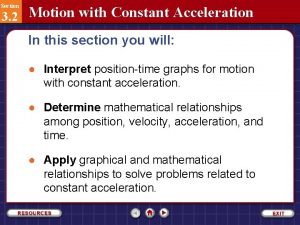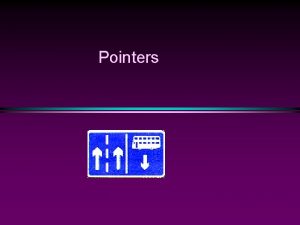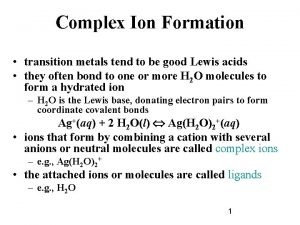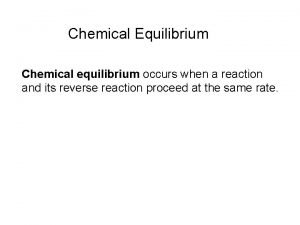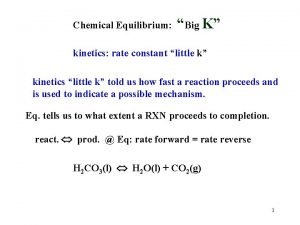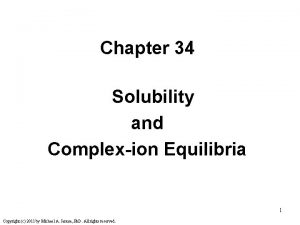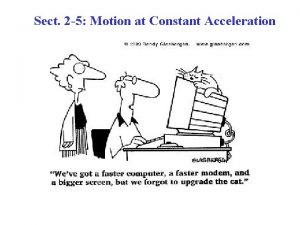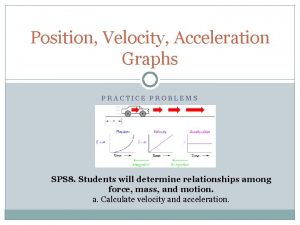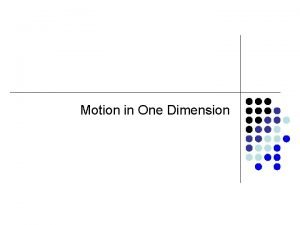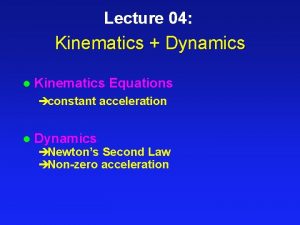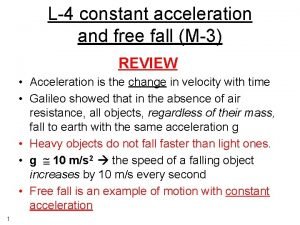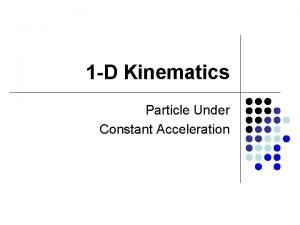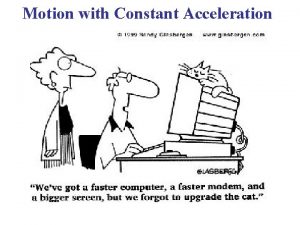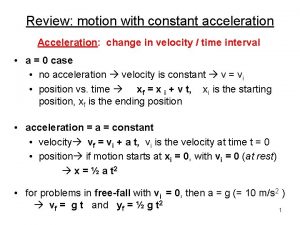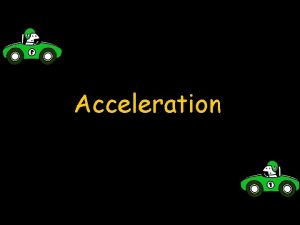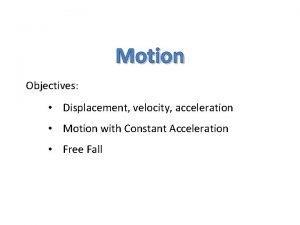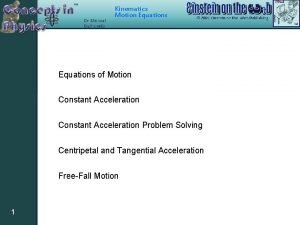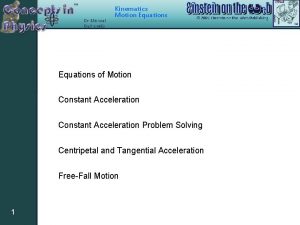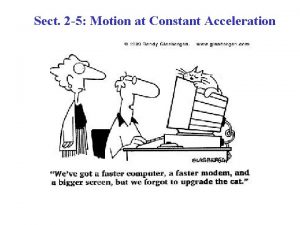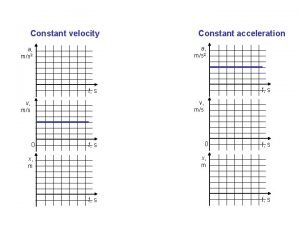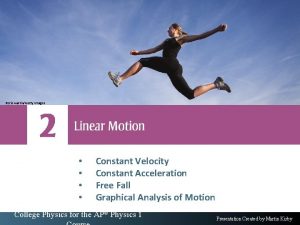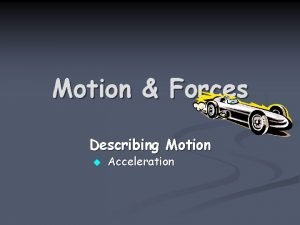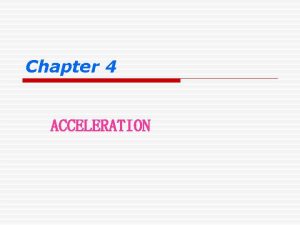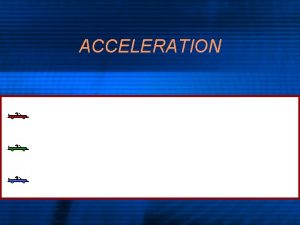Review motion with constant acceleration Acceleration change in























- Slides: 23

Review: motion with constant acceleration Acceleration: change in velocity / time interval • a = 0 case • no acceleration velocity is constant v = vi • position vs. time xf = x i + v t, xi is the starting position, xf is the ending position • acceleration = a = constant • velocity vf = vi + a t, vi is the velocity at time t = 0 • position if motion starts at xi = 0, with vi = 0 (at rest) x = ½ a t 2 • for problems in free-fall with vi = 0, then a = g (= 10 m/s 2 ) vf = g t and yf = ½ g t 2 1

Review: Free fall- object projected vertically up • time to reach the maximum height Position, y H tup 0 2 tup Time, t • total time in the air Velocity, v vi UP DOWN Time, t vi Free fall is an example of motion with constant acceleration in one direction only (up and down), today we will take up motion in both the horizontal and vertical directions simultaneously projectile motion. 2

example Problem: An object is dropped from rest from a height of 20 m above the ground. (a) How long will it take to reach the ground? (b) What is its velocity as it hits the ground? Solution: initial velocity, vi = 0 y f = ½ g t 2 , v = g t 3

L-5 Projectile motion • A projectile is an object that is thrown, hit, kicked, shot, etc. , and then travels under the influence of gravity. • It is an example of two-dimensional motion. 4

Projectile Examples • • • Tennis ball Golf ball Football Softball Soccer ball bullet • • • Hockey puck or ball Basketball Volleyball Arrow Shot put Javelin These are all examples of things that are launched, then move under the influence of gravity (and air resistance) 5

Not projectiles • • • Jet plane Rocket Car (unless it looses contact with ground) catapult (before rock leaves) slingshot (before rock leaves sling) 6

Unintended projectile 7

Projectile motion force of gravity • • • the key to understanding projectile motion is to realize that gravity acts in the vertical (downward) direction gravity affects only the vertical motion, not the horizontal motion we will ignore air resistance 8 8

Demonstration • We can show that the horizontal and vertical motions are independent • The red ball was released and falls vertically down • The yellow ball was given a kick to the right. • They track each other vertically step for step and hit the ground at the same time 9

Galileo’s inclined plane experiments NO! YES! 10

Target practice In the absence of gravity a bullet would follow a straight line forever. With gravity it FALLS AWAY from that straight line! 11

Hitting the target – aim high, not directly at the target 12

Sports without gravity 13

Baseball Every hit ball is a line drive, If hit upward, a homerun Pop-ups never come down. 14

Basketball – no jump shots! Without gravity With gravity 15

Kicking field goals would be easier! 100 yard field goals would be possible. 16

Height Path of the Projectile: parabola falling rising v Distance down range angle of elevation projectile g v Vertical velocity Horizontal velocity 17

Projectile motion – key points 1) The projectile has both a vertical and horizontal component of velocity 2) The only force acting on the projectile once it is released is gravity (neglecting air resistance) 3) At all times the acceleration of the projectile is g = 10 m/s 2 downward 4) The horizontal velocity of the projectile does not change throughout the path 5) On the rising portion of the path gravity causes the vertical component of velocity to decease 18

key points-continued 6) At the very top of the path the vertical component of velocity is ZERO 7) On the falling portion of the path the vertical velocity increases 8) When the projectile lands it will have the same vertical speed as it began with 9) The time it takes to get to the top of its path is the same as the time to get from the top back to the ground 10)The range of the projectile (horizontal distance travelled) depends on its initial speed angle 19 of elevation

Maximum Range • When an artillery shell is fired the initial speed of the projectile depends on the explosive charge which cannot be easily changed • The only control is setting the angle of elevation. • You can control the range (where it lands) by changing the angle of elevation • To get maximum range set the angle to 45° 65° 45° 25° 15° 20

NEWTON The ultimate projectile: putting an object into orbit • Imagine trying to throw a rock around the world. • If you give it a large horizontal velocity, it will go into orbit around the earth! 21

Geosynchronous Satellite that always remains above the same point on the earth. Must have an orbital period of 24 hours. Altitude is 22, 000 miles. 22

Escape from planet earth • To escape from the gravitational pull of the earth an object must be given a velocity larger than the so called escape velocity • For earth the escape velocity is 7 mi/sec or 11, 000 m/s, 11 km/sec or about 25, 000 mph. • The spacecraft gets a boost by using the gravitational slingshot effect 23
 Section 2 motion with constant acceleration
Section 2 motion with constant acceleration Linear motion with constant acceleration
Linear motion with constant acceleration Chapter review motion part a vocabulary review answer key
Chapter review motion part a vocabulary review answer key Constant pointer and pointer to constant
Constant pointer and pointer to constant What is pointer to pointer in c
What is pointer to pointer in c Constant pointer and pointer to constant
Constant pointer and pointer to constant Metals tend to be
Metals tend to be Equilibrium of chemical reactions
Equilibrium of chemical reactions Rate constant vs equilibrium constant
Rate constant vs equilibrium constant Complex ion equilibria
Complex ion equilibria Constant pointer and pointer to constant
Constant pointer and pointer to constant Display the address of intval using cout and intptr.
Display the address of intval using cout and intptr. Potassium lithium
Potassium lithium Cake resistance formula
Cake resistance formula Gas constants
Gas constants Constant acceleration equations
Constant acceleration equations Position velocity acceleration graphs practice
Position velocity acceleration graphs practice Constant acceleration equations
Constant acceleration equations Dynamics vs kinematics
Dynamics vs kinematics Free fall acceleration
Free fall acceleration Ms-1
Ms-1 Kp kv ka control system
Kp kv ka control system What does constant acceleration mean
What does constant acceleration mean Particle under constant acceleration
Particle under constant acceleration
